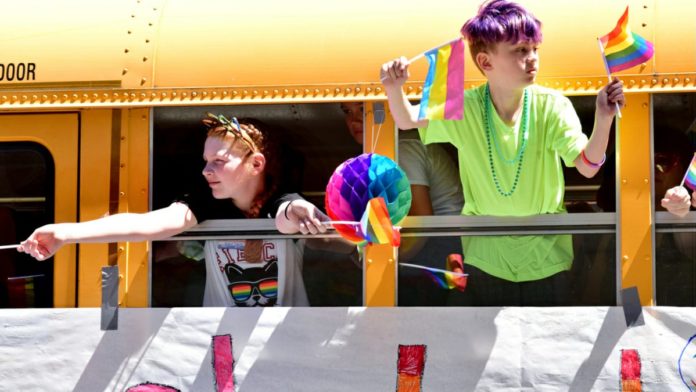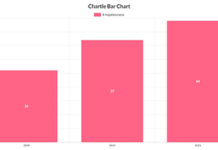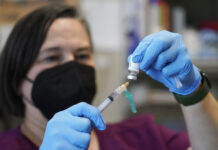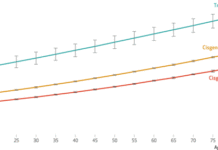
In her TEDxMinneapolis talk from 2020, Angela Goepferd, MD, chief education officer and medical director of the Gender Health program at Children’s Minnesota, recalls an interaction she had at the workplace with a curious 3-year-old some years ago. “Are you a mommy or a daddy?” the little boy asked earnestly. Goepferd smiled and bent down to be eye-level with him. “You know, I’m not a mommy or a daddy … I’m a ‘mapa.’ A mommy and a daddy, so both.” Without skipping a beat, the boy replied, “Oh. Okay! So then, what’s your favorite dinosaur?” The retelling of that dialogue elicited smiles and chuckles from the audience, as it goes to show how children move through the world with non-judgemental innocence. But it also illuminates just how society stands to gain by accepting everyone, irrespective of gender.
Exchanges like this one, compounded with an unmet need in the community (and Goepferd’s own personal experience), laid the impetus for the Gender Health program at Children’s Minnesota, the only one of its kind in the state of Minnesota. Co-founded in 2019 by Goepferd and an endocrinologist from Children’s Minnesota (“we were treating the same patients”), their shared vision was to provide comprehensive and coordinated services for transgender and gender-diverse kids and their families.
At a Disproportionate Risk
A space that wholly welcomes, understands, and treats individuals who feel as if they were born in the wrong body is a matter of life or death for some: Newly-released data from Trevor Project shows that 42 percent of LGBTQ kids have contemplated suicide over the past year. “The suicidality rates compared to their cis-gender or straight peers is extremely high,” says Goepferd. “Three in four transgender youth experience high rates of anxiety and depression, and two in three of them––so 67 percent of trans and non-binary youth––experience symptoms of major depression.” When your very existence is on the debating room floor, Goepferd says, it’s easy to go to a dark place.
Last month, the LGBT+ advocacy group Human Rights Campaign pronounced 2021 “the worst year” for bills challenging gay and transgender rights in U.S. states. “When you’re getting messages all the time that are taking negative perspectives of who you are and your identity, and hurting you with words and physical violence, it’s no wonder these kids have higher rates of anxiety and depression and struggle with hopelessness,” she says. Additionally, curbed access to healthcare means coping with substances and high-risk sexual behavior.
“Puberty blockers are valuable medication, very well studied, and monitored closely by medical professionals––always done with the parents on board,” she says. “The treatment is completely reversible, endorsed by the American Psychological Association [among other reputable health organizations] and yet, despite all that, we have attempts to legislate this treatment away from kids.”
Goepferd says she’s assembling trivia for Pride Month and working in stats like how, for example, only 20 percent of LGBT kids got sexual health information last year that was relevant to them. This, when 15-20 percent of Generation Z identify as LGBTQ as they come into adulthood––the highest subgroup ever in the category of sexual orientation. “And still, they aren’t getting education on keeping themselves safe!”
Puberty suppression is, according to Goepferd, a fully reversible medical intervention that’s used to put a ‘pause’ button on the time in life where adolescents achieve rapid physical growth and sexual maturity. Think of it like this, she says: “If you’re assigned male at birth but you identify as female, as you approach puberty, your body is going to masculinize in ways that are largely permanent—your voice gets deeper, you grow hair on the face and body, you get an Adam’s apple. Later in life, in order to feel affirmed and comfortable in your body, you now have to go through painful and expensive medical procedures to undo the effects of puberty.” 90 percent of trans adults say they wished they had access to puberty blockers when they were younger. “For the people that didn’t, their suicide attempt rates were far higher than others.”
A Safe, Comprehensive Community Space
“The message we were hearing from colleagues around the state, around the region, was that there wasn’t a lot of places for kids to go to,” she says. “There’s a family practice in St. Paul that offers some services for transgender teens, but they had hundreds of patients and couldn’t serve everyone effectively. The University of Minnesota has a mental health program [for transgender and gender-diverse kids] but the waiting list is something like, well over a year long.”
Getting both medical and mental health treatment meant bopping around from one place to the next, highlighting serious holes in health care for this particular population. Up until 2019, there was no local full-service provider that offered a continuum of care for transgender and gender-diverse kids. “So, we thought Children’s could step up and fill that void in the greater community,” says Goepferd. When doors opened, the annual caseload was estimated to be at 90 individuals. By year’s end, they tallied around 200 patients––about three times what was initially projected.
“A unique thing about this program is that it’s exclusively pediatric and we’re multi-specialty,” Goepferd says. “There are certainly clinicians in town who provide care to kids but with our model, we have pediatricians, physicians in adolescent health, gynecology health, endocrinology, and [within the last year] psychological and psychiatric services. We can really give comprehensive care in a compassionate setting to kids.” Plus, she adds, adults are more comfortable taking their children to a place that’s grounded in pediatric care versus something adult-based.
Gender Affirming Care
Every family that calls to request more information receives an initial consultation, where they learn more about the program and get their burning questions answered. An intake appointment gets scheduled from there to go over components like gender identity and medical history, potentially undergo a physical exam (for puberty staging purposes), explore possible treatment options, and more.
“Some will want medical interventions, others won’t,” Geopferd says. “Some kids will be early in their journey and just unsure about their names and pronouns. Everyone’s at a different stage, so we’re getting to know each other. Some families come in just once and get their questions answered and life goes on and kids change and, well, that’s totally great! I just want to be there for every step of the journey.” Should a trans child start treatment, like hormone therapy or puberty suppressant medications, they’ll undergo follow-up care in the form of X-ray monitoring, labs, and/or psychiatric help.
“We’re also helping families learn how to talk to the school [when a child transitions], what questions to ask, how to navigate the bathroom situation,” she says. Sixty-three percent of transgender children hold in their urine for a full school day in fear of bathroom assaults.
“I had a kid drive from another state to see me so that the superintendent would allow them to use the bathroom aligned with their gender identity,” she exclaims. “Just so they could pee at school!”
Pride Month Tips on Gender-Neutral Language
In honor of Pride Month, the PRIDE employee resource group (ERG) at Children’s Minnesota provided the following examples of how to be more inclusive and gender-neutral during everyday conversations:
- Instead of saying, “Hey guys”, or “Hello ladies” consider, “Hi folks” or “Hello friends” to be gender inclusive.
- Instead of saying “What does your husband do?” or “You’re married! Tell me about your wife,” try using “Tell me about your spouse” or “I’d love to learn more about your partner” to be inclusive of LGBTQ relationships.
- When asking kids about their families, instead of saying “Mom and Dad,” trying saying, “parents” or “grown-ups” to be inclusive of the multiple ways that love makes a family.
- Introduce yourself with your name and preferred pronouns and then ask colleagues, friends and patients, “What’s your name?” and “What pronouns do you use?”
- Everyone makes mistakes. If you mistakenly misgender someone the best advice is to apologize and move on.
- Instead of using words such as “waiter” or “waitress,” use the gender-neutral job title of “server.” Another example would be using “flight attendant” instead of “stewardess” in the airline industry. Inclusive language avoids using gendered job titles.








